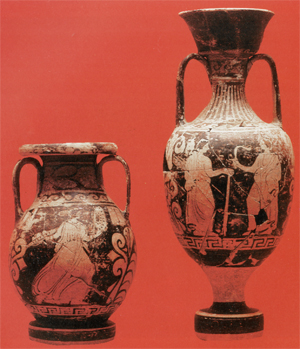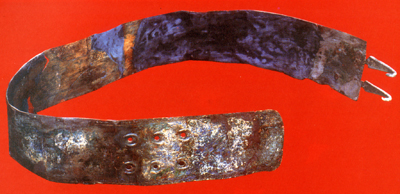Lucanians, the hellenistic world and the foundation of the cityby Attilio MastrocinqueThe archaeological area where was built the city of Grumentum, just as nowadays we can see and appreciate, has an history much older than we can imagine. In fact before the arrival of Romans, Grumentum was already a thriving and important city founded by the indigenous population of Lucanians; the wonderful materials still preserved in the archaeological museum are direct evidence of this historical period.
Flourished in the thriving historical frame of Magna Graecia, the Greek colonies universe of southern Italy, Lucanians population combined a great native culture with a strong influence from the Greek world. Our knowledge of the lucanian Grumentum is not too much, but we are sure that played a key role in the peopling of the area, especially for its strategic geographical position, placed in the middle controlling all the Agri river valley, position that gave to the city a continuity of life until the early Middle Ages. In the Hellenistic period (i.e. the time when Grumentum was still a lucanian city, before the arriving of Romans),also the territory of the middle Agri river valley had to be populated and put under cultivation, as evidenced by many discoveries of agricultural settlements and farms in the area. The rural one is the most documented type of settlement also during Lucan period, because the most functional one to the exploitation of agricultural and wooded resources of the area.
From the area come also several tracks of older non-urban settlements, especially of the Hellenistic period, such as the necropolis of Montemurro, where were found about fifteen graves, assembled together in four groups, provided with rich equipments. The kits include items of personal ornament (such as a bronze belt contained in a male burial), figurative pottery and ceramics of local manufacturing, most of them black glazed. The chronology of the rich necropolis of Montemurro looks like included in the second half of the fourth century B.C. Among these tracks it’s reported also a votive deposit (i.e. a pit in which were placed the ex-voto) in locality San Marco, concerning a shrine standing just outside the area of Grumentum.
|





 The Roman presence in Grumentum area became strong during the third century, later on the third Samnite war.Grumentum was conquered by Rome, and the city flourished again especially from the middle of the first century B.C., after sending out
The Roman presence in Grumentum area became strong during the third century, later on the third Samnite war.Grumentum was conquered by Rome, and the city flourished again especially from the middle of the first century B.C., after sending out 